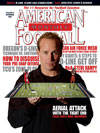AMERICAN FOOTBALL MONTHLY THE #1 RESOURCE FOR FOOTBALL COACHES
Article CategoriesAFM Magazine
|
Zone Play Concepts and Techniquesby: Eddie WilliamsonAsst. Head Coach/Offensive Line Coach, TCU © More from this issue We have a very diverse offensive system at TCU. The breadth of our offensive system forces our linemen to develop a number of skills. We try to have our schemes carry similar patterns, concepts and elements to reduce the amount of practice time used for learning plays. We try to invest most of our practice time in technique training. The Zone Play has been traditionally one of our most productive plays. We use it as well to establish a physical personality for our offense and we believe its productivity increases as the game proceeds. On the inside and outside zone we have a couple of principles that our players learn if they are leading a zone block, supporting or helping a zone block or if they are basically by themselves in a single block. All of our linemen look to the backside of the play call if they are covere....The full article can only be seen by subscribers. Subscribe today!
|
|
|||||||
| HOME |
MAGAZINE |
SUBSCRIBE | ONLINE COLUMNISTS | COACHING VIDEOS |
Copyright 2025, AmericanFootballMonthly.com
All Rights Reserved





